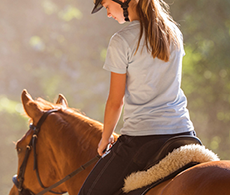
Six tips for horse riding in summer
Riding in the summer can be lovely, but also dangerous if you’re not sure how to deal with the heat. Follow these tips to keep you and your horse safe in hot weather.
Riding in the heat can present a risk for you and your horse, but there are steps you can take to ensure you both stay as safe as possible when the weather's warmer. By following our tips, you can continue to exercise your horse safely to help prevent weight gain and obesity or the risk of laminitis – and just to keep them happy.
Luckily, there are plenty of things you can do to keep you and your horse safe throughout the summer.
1. Avoid the hottest times of day
The easiest thing you can do is to avoid riding during the hottest parts of the day. The sun is strongest between 11am and 3pm, so – while you should avoid riding between these times whenever possible – the earlier or later you can ride, the better.
During a heatwave, it’s likely to be too hot outside, so keep an eye on the forecast, set your alarm and get up early to enjoy the best part of a summer’s day.
Consider where you’re riding and the type of riding you’re doing, too. A steady hack in the woods would be a better option than a schooling session in an outdoor school with no shade.
Plus, be mindful of your horse’s fitness, as an overweight horse is likely to struggle more in hot weather.
2. Cover up and apply sunscreen
Keeping your skin covered will offer protection from the sun’s harmful UV rays – and often you’ll find that wearing a lightweight and breathable long-sleeved top will keep you cooler compared with wearing a T-shirt when out in the sun.
All clothing will provide some level of UV protection but look out for technical garments that have an ultraviolet protection factor (UPF) score, which will be in the form of a percentage showing how much UV is blocked by the fabric. Similar to SPF in sunscreen, the higher the number, the greater the protection.
The same applies when you’re shopping for your horse – fly rugs, summer sheets and fly masks will usually come with a UPF rating.
Ensure that you’re regularly topping up your sun cream to help prevent burning, which is a risk even when it’s cloudy. If your horse has any pink skin, such as on his muzzle, he’ll need sunscreen, too.
Look for a horse-specific cream that is waterproof and will stay on well. Failing this, you can also use children's sunblock – 30 SPF minimum – but always conduct a patch test first to ensure your horse isn't allergic to it.
3. Watch out for concussion
While summer can be one of the best times of the year to ride your horse, a prolonged period of hot weather can cause the ground to harden – and your horse may not have had enough time to adapt to it.
Riding on hardened ground can result in concussion – one of the major factors in horse lameness. Concussion happens due to the force sent up the horse’s leg every time their hoof hits the ground. To prevent this, be sure not to overdo road work, mixing up your rides with different terrains such as grass.
For more tips on how to avoid concussion and the symptoms to watch out for, read our equine concussion article.
4. Arm against flies
Flies and midges are at their most active in the summer months. Not only are they annoying, but they can cause skin irritations, such as sweet itch, too.
You can use fly sprays, gels, masks, fringes and ride-on fly rugs to protect your horse from flies while you’re riding, depending on how badly they’re affected and whether it’s appropriate for your ride.
5. Cool off after riding
When you return from a ride, hose down your horse with cool water all over their body, stand them in the shade and offer them a drink of water.
Hosing helps speed up the cooling process and removes sweat from their coat. It’s a myth that the water heats up on the horse if you don’t scrape it off, so you can turn them out wet – this isn’t a problem.
6. Stay hydrated
The single most important thing you can do in hot weather is to keep both you and your horse hydrated. Horses can easily double their normal water intake in hot weather, so be prepared for this.
Knowing what’s normal for your horse is important so that you can quickly identify when something is wrong. Remind yourself of the signs of dehydration and feed electrolytes to help replace those lost through sweating.
And finally…
If you get to the yard a little later than you planned or find it’s slightly hotter than you anticipated, don’t risk it.
Even with all the extra precautions you can take to keep you and your horse hydrated, cool and out of the sun, a day of training in severe heat isn’t worth the risk.
Do you have any tips for riding in warmer weather? Head to our Petplan Equine Facebook page and let us know in the comments.


